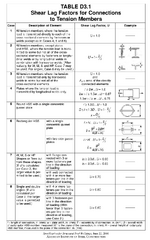217808,
#1 The specification does not state the length of the weld must be greater than the width of the HSS. In my opinion the l >= H notation notes the limit of applicability of the simple formula.
Mike, I stand corrected on this being a hard limit. I agree with your interpretation.
In the following article, Packer had a chance to say it's a limit, but he didn't. He said "This limited information tends to discourage connections with Lw < H or D." It's not clear if "this limited information" refers to lack of research findings or lack of equations for designers!
#2 How do you know AISC would say no? Do you know of anything they've said on this topic?
Based on #1, I'm 99% sure they would say the equations don't apply, so you're on your own to make sure tensile rupture is OK. If you haven't already, I'd recommend studying the Martinez-Saucedo and Packer paper (ref in the link above). I *think* their Eq. 5 applies for smaller Lw/D.
Here's where it gets a little tricky for me. Your seal says you designed per the Specification, which provides equations for your exact situation except that you're choosing to violate the applicability limit. It feels a bit like violating the typical standard of care, which a forensics engineer would jump all over. I'll have to ponder this to see what I think about it.
#3a Yes, an FEA could be performed.
OK, if such an FEA is planned for this project.
#3b No, there doesn't appear to be any literature on short welds, at least not that I was able to find. Hence the limit of applicability of the simple formula.
In that case, we're left to guess at what bad things might happen.
My best guess is the weld might be adversely affected, so I wouldn't design the weld to the limit. Earlier, you said Ru = 100 kips (+/-). 3/16 in. fillet welds, 6 in. long would provide phiRn = 1.392*3*6*4 = 100 kips, so the weld strength ratio = 1.00. There might be unanticipated stress concentrations in the welds. Also, if the slot is 1/8 in. wider than than the gusset, all of that might be on one side. You'd be depending on the fabricator/welder to increase the weld size to compensate. I've always wondered how likely they are to do this. I'd probably either go to 1/4 in. or use 7 in. long to back the strength ratio off from 1.00.



